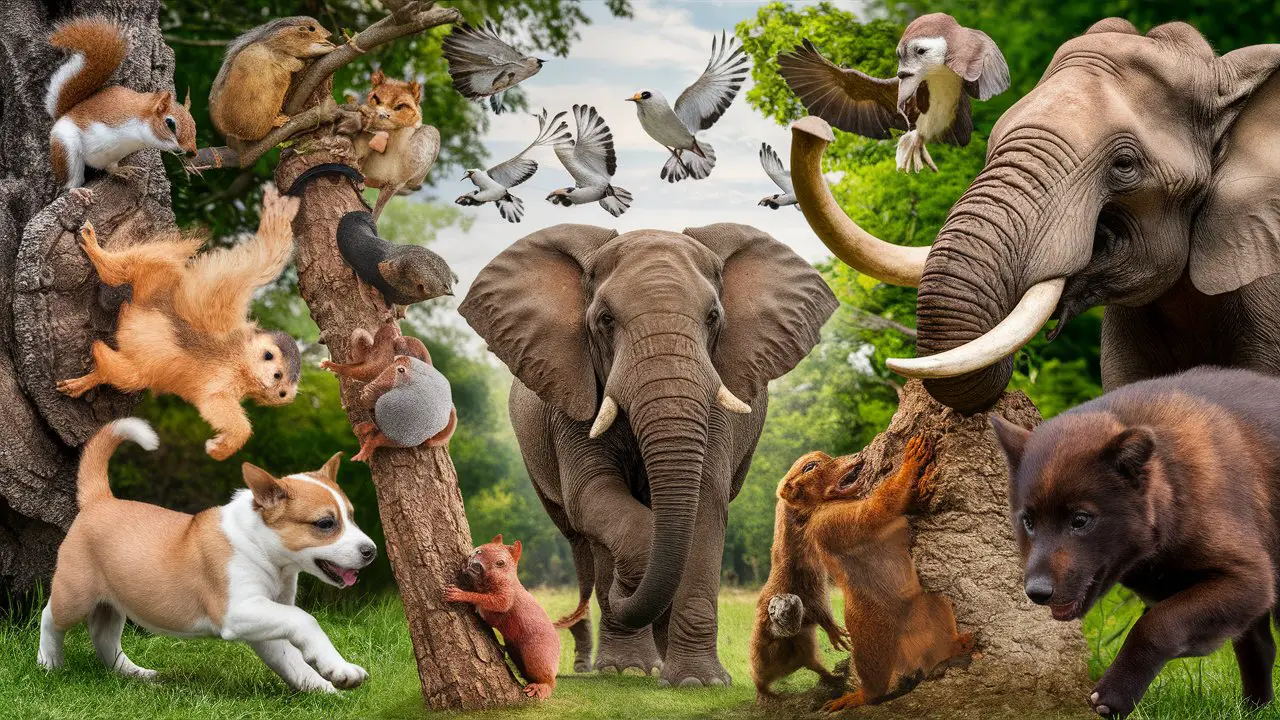As you dive into this article, consider the remarkable advances that contemporary animal behavior research has made. For decades, scientists have worked diligently to better understand the complexities of animal behavior. Their studies have unveiled captivating insights into how different species interact, communicate, and adapt to their environments. Prepare to be fascinated by the innovative techniques researchers now utilize, such as animal-borne video cameras, GPS tracking, and drones. The resulting discoveries have transformed our comprehension of the behaviors and cognitive capabilities of numerous animals. From the navigation strategies of sea turtles to the social dynamics of chimpanzees, this piece illuminates some of the most compelling contemporary breakthroughs in the ever-evolving field of animal behavior research. Let us explore together and appreciate these extraordinary developments.
The Evolution of Animal Behavior Research
Early Observations
Early studies of animal behavior were primarily observational, dating back to Aristotle in the 4th century BCE. These observations were descriptive but lacked controlled experimentation. Prominent ethologists of the 19th and early 20th centuries, such as Charles Darwin and Konrad Lorenz, helped establish animal behavior as a serious scientific discipline through detailed observations and descriptions of behavior in natural settings.
Experimental Studies
In the mid-20th century, the study of animal behavior transitioned to more experimental methods. Researchers conducted controlled experiments, often in laboratory settings, to test hypotheses about the causes and functions of behaviors. For example, Tinbergen performed experiments demonstrating that seagull chicks would peck at red spots on their parents’ beaks, a behavior essential for eliciting feeding. These experimental studies represented a major turning point, allowing researchers to move beyond description and uncover the mechanisms underlying behavior.
Contemporary Advances
Today, animal behavior research utilizes a combination of observational and experimental methods, often enhanced with new technologies. Video recording and automated tracking systems allow fine-scale analysis of behavior in naturalistic environments. Genetic tools enable the manipulation and monitoring of neural circuits that control behavior. Computational approaches help researchers analyze and model the complex relationships between genes, neurons, environment, and behavior. These contemporary techniques have accelerated our understanding of how and why animals behave in the ways they do.
The study of animal behavior has progressed rapidly, from basic observations of the natural world to sophisticated experiments that reveal the biological underpinnings of behavior. Powered by modern tools and technologies, animal behavior research continues to provide fundamental insights into the relationships between brain, body, and environment.
Key Areas of Focus in Modern Animal Behavior Studies
Learning and Social Cognition
Animal behavior research has focused extensively on how animals acquire and apply knowledge. Studies examine how animals learn through conditioning, observation, and instinct. Researchers also explore how animals think about social relationships, assess the mental states of others, and navigate complex social environments.
Communication
Animal communication is a broad area of study. Researchers investigate how animals use visual displays, sounds, scents, and touch to share information. Topics include the meaning and function of signals, the neural mechanisms behind communication, and the evolution of communication systems. Studies have revealed the rich social lives of animals and their highly developed abilities to cooperate, form alliances, and even deceive.
Foraging and Movement
How animals find and acquire food resources is a central issue in behavior research. Scientists study the motivations behind foraging, the mechanisms enabling animals to navigate, and the cognitive skills required to locate scarce resources. Movement and migration are also closely tied to foraging. Researchers track how animals traverse challenging terrain, migrate long distances, and establish home ranges. These studies provide insights into orientation, navigation, and spatial memory.
Applied Research
Some animal behavior research has direct applications. Scientists explore how to mitigate human-wildlife conflicts, conserve endangered species, and control agricultural pests in an ethical manner. Researchers also study how to improve animal welfare in captivity and maximize psychological well-being. By gaining a better understanding of behavior, we can find compassionate solutions to social and ecological challenges.
Innovative Research Methods in Animal Behavior
Researchers are employing innovative techniques to gain new insights into animal behavior.
Technological Advancements
Advances in technology have allowed scientists to track animals in ways never before possible. Miniaturized GPS devices, for example, enable researchers to follow animals in the wild over long distances and time periods. Drones equipped with cameras provide an aerial vantage point for observing animals in inaccessible or dangerous areas. Motion-activated cameras with night vision capture behavior in low-light conditions or nocturnal animals. These tools give researchers an intimate look into the lives of animals in their natural environments.
Genetic Analyses
Analyzing an animal’s DNA and RNA provides clues about its behavior and evolution. By sequencing genomes, scientists can identify genes linked to certain behaviors. They can also determine how closely related different species and populations are, which helps in understanding the origins of behavior. The field of epigenetics examines how environmental factors influence the expression of genes, including those involved in behavior. Epigenetic changes acquired during an animal’s lifetime can sometimes even be passed down to offspring.
Computational Approaches
Advances in computing power and machine learning have enabled new computational approaches to studying behavior. Computer simulations and modeling can recreate complex behaviors and test theories about their evolution or function. Researchers can also employ machine learning to detect patterns in huge amounts of behavioral data that would be impossible for humans to analyze manually. These computational tools open up promising new avenues for exploring the mechanisms underlying behavioral traits.
Innovative research methods are revolutionizing the field of animal behavior and deepening our understanding of the fascinating behavioral diversity in the natural world. These new tools enable scientists to address long-standing questions about how and why animals behave in the ways they do.

The Ethical Implications of Animal Behavior Experiments
Animal behavior experiments provide crucial insights into cognitive abilities, social dynamics, and biological mechanisms that shape behavior. However, these experiments also raise important ethical questions regarding the humane and ethical treatment of animals.###
Balancing Scientific Value and Animal Welfare
There is an ongoing debate regarding how to balance the scientific value gained from animal behavior experiments with concerns for animal welfare. Researchers must ensure that experiments do not inflict unnecessary pain, distress or lasting harm. This requires careful regulation and oversight, as well as efforts to refine experimental methods, reduce sample sizes, and replace live animals when possible. At the same time, overly restrictive policies could hamper scientific progress. Finding an ethical balance is crucial.
The Problem of Captivity
Even in the best conditions, captivity can negatively impact the behavior, health and lifespan of animals. Animals in laboratories are confined to relatively small enclosures and subjected to stresses like handling, restraint and isolation that would not occur in nature. This can make it difficult to extrapolate findings from captive animals to natural behaviors and relationships. Some argue this undermines the scientific validity and applicability of the research.
The Moral Status of Animals
Some argue that any use of live animals for research raises moral concerns, as animals are living beings that can suffer and feel distress. However, others argue that while we should aim to minimize harm, the responsible and humane use of animals for scientific purposes can be justified if there are clear benefits and no viable alternatives. This debate reflects deeper questions about the moral status of animals and their relationship to humans.
In summary, while animal behavior experiments provide valuable scientific insights, they also raise serious ethical questions. Balancing these factors requires open discussion and a shared commitment to minimizing harm. With careful regulation and conscientious experimental methods, researchers can study animal behavior in an ethical fashion. But we must never lose sight of our moral duty toward the animals that make this important work possible.
Promising Breakthroughs in Understanding Animal Behavior
In recent years, advancements in technology and research techniques have enabled promising breakthroughs in the field of animal behavior. Scientists now have innovative tools to gain insight into the cognitive processes and social dynamics of animals like never before.
Neuroimaging Allows a Window into the Animal Mind
Techniques such as functional magnetic resonance imaging (fMRI) allow researchers to scan the brains of awake, behaving animals as they engage in cognitive tasks. By measuring changes in blood flow, fMRI shows which regions of the brain are activated, providing a window into the animal’s mind. For example, researchers have used fMRI to demonstrate that dogs have voice area in their brains, just like humans, that activate when they hear human speech.
Genetic Engineering Enables Precise Manipulation
The emergence of CRISPR gene editing technology gives scientists the ability to manipulate animal genomes with high precision. By inserting, removing, or modifying specific genes, researchers can study how genetics influence behavior and cognition. For instance, researchers recently used CRISPR to create macaque monkeys with a human version of the MCPH1 gene, which is important for brain development. The modified monkeys demonstrated better short-term memory compared to normal macaques, revealing insights into the genetics of human cognition.
Automated Tracking Reveals Complex Social Dynamics
Advances in computer vision and machine learning have enabled the automated tracking and analysis of social behaviors in groups of animals. By using algorithms to track the movements, proximity, and interactions of individuals in a group, scientists can gain a holistic understanding of social dynamics that was previously impossible. For example, researchers used an automated tracking system to analyze the relationships and power structures between individuals in groups of pigs. The system revealed complex social hierarchies and even allowed predictions of how the group would reorganize if an individual was removed.
These promising new tools are enabling discoveries that revolutionize our understanding of animal minds, behavior, and sociality. With continued progress, the future of animal behavior research looks bright. Scientists have more opportunities than ever before to gain fascinating insights into our fellow inhabitants of this planet.
Don’t Miss a Thing! Enhance Your Wildlife Photography with Ultra-X Night Vision Goggles.
Get Now!

Conclusion
As you have seen, animal behavior research continues to develop and progress in exciting new directions. From investigating the social dynamics of primate groups to unraveling the navigation abilities of migratory birds, researchers are gaining fascinating insights into the complex cognitive and behavioral capacities of animals. As technology advances, scientists can study animal behavior and physiology in ever more sophisticated ways. There is still much to discover about the inner lives of animals, and the field of animal behavior promises to remain an active frontier of scientific inquiry. With a spirit of curiosity and rigor, researchers will keep pushing the boundaries of our understanding, bringing us new appreciation for the diverse, intricate, and often surprising ways animals interact with the world. You now have a broad overview of some of the most compelling contemporary advances in this dynamic, multifaceted area of study.





